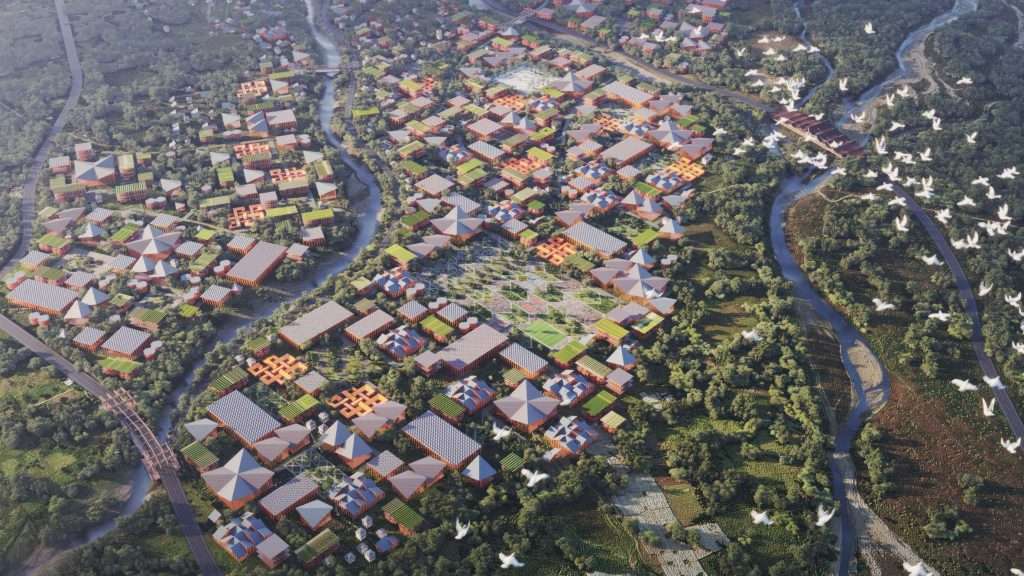
Table of Contents
1. Introduction
In the heart of the Himalayan kingdom of Bhutan, a revolutionary urban project that’s going to go into the history books, is taking shape. The Gelephu Mindfulness City, announced by His Majesty King Jigme Khesar Namgyel Wangchuck on December 17, 2023, represents a bold step towards sustainable and mindful urban development in a nation known for its Gross National Happiness philosophy. This post explores the journey of Gelephu from its historical roots to its envisioned future as a beacon of mindful urban living, examining the project and its potential to redefine urban development in the 21st century.
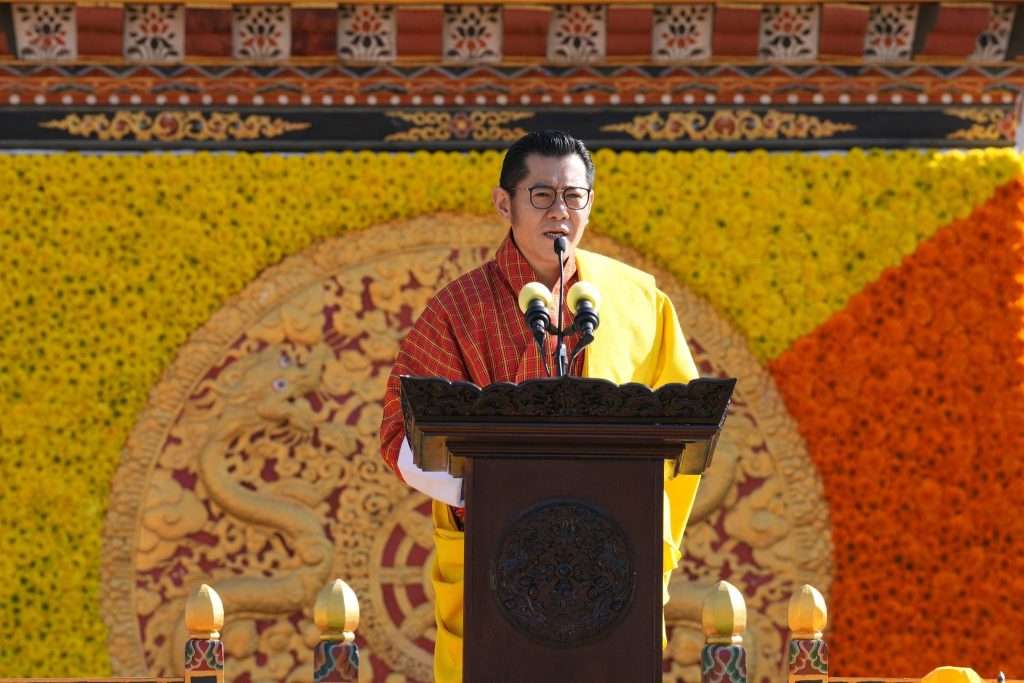
The Gelephu Mindfulness City project is not merely an urban development initiative; it is a manifestation of Bhutan’s commitment to holistic progress, blending economic growth with environmental conservation, cultural preservation, and the well-being of its citizens. As we get into the details of this ambitious project, we will uncover how it seeks to address some of the most pressing challenges of our time – from climate change and biodiversity loss to social inequality and economic sustainability.
In the following pages, we will trace the historical context that has shaped Gelephu, explore the unique development philosophy of Bhutan, and examine in detail the vision, planning, and potential impact of the Mindfulness City. We will also consider the challenges that lie ahead and the global significance of this pioneering project. Through this comprehensive exploration, we aim to provide a nuanced understanding of how Gelephu Mindfulness City could serve as a model for future urban development worldwide.
2. The History of Gelephu
To truly appreciate the significance of the Gelephu Mindfulness City project, we must first understand the rich history of the region. Gelephu, situated in the southern Sarpang District of Bhutan, has a story that spans centuries, evolving from a small settlement to a crucial border town, and now poised to become a groundbreaking urban center.
Early Settlement and Indigenous Inhabitants
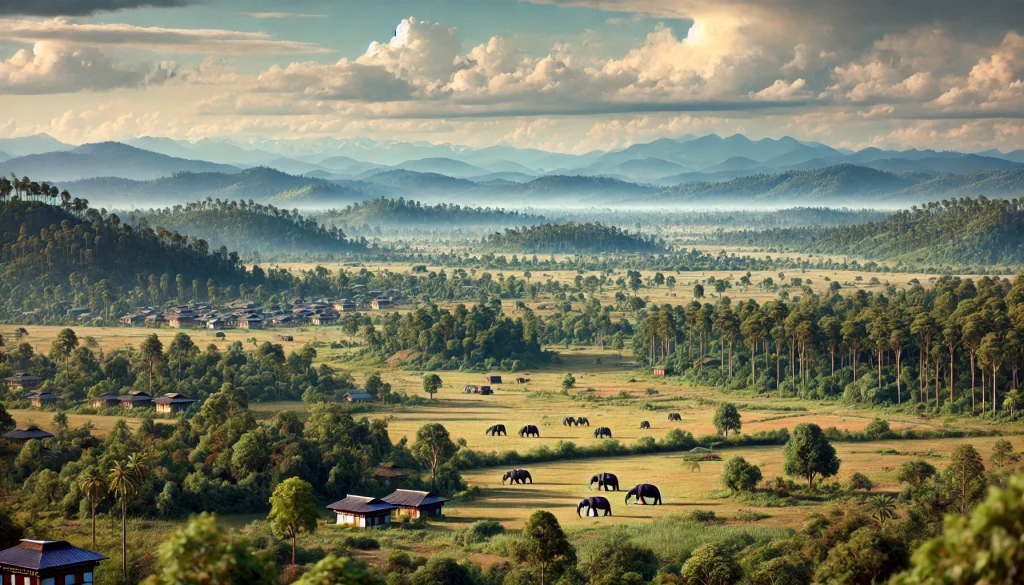
The area that is now Gelephu was initially inhabited by indigenous tribes, primarily the Bodo, Sautal, Meche and Immigrant people of Nepali descent. These early settlers were drawn to the region’s fertile plains and abundant natural resources. The lush subtropical climate and proximity to numerous rivers made it an ideal location for agriculture and hunting-gathering societies.
Archaeological evidence is scarce and no study has been carried out that suggests human habitation in the region dating back several thousand years. The people developed a deep connection with the land, creating a rich tradition primarily centered around a beautiful fusion of Hinduism and Buddhism, and sustainable living practices that respected the natural environment.
Rise as a Trading Hub
By the 18th century, Gelephu had emerged as a trading point between Bhutan and the neighboring Indian regions. Its strategic location along ancient trade routes facilitated the exchange of goods such as textiles, spices, and agricultural products. The town became a melting pot of cultures, where Bhutanese traders met with their Indian counterparts, exchanging not just goods but also ideas and cultural practices.
Key factors that contributed to Gelephu’s rise as a trading hub include:
- Strategic location at the foothills of the Himalayas
- Access to multiple river systems for transportation
- Fertile land producing surplus agricultural goods for trade
- Cultural and linguistic similarities with neighboring Indian communities, facilitating communication and commerce
This period saw the gradual development of infrastructure to support trade, including the construction of basic roads, rest houses for traders, and storage facilities for goods. The economic activity brought by trade led to the growth of the settlement, attracting more people to the area and diversifying its population.
Modern Development
The 20th century marked a period of significant transformation for Gelephu, as Bhutan began to engage more actively with the outside world and modernize its infrastructure and governance systems.
Key developments during this period include:
- 1960s: Establishment of the first modern administrative offices, marking Gelephu’s growing importance in the region
- 1980s-1990s: Expansion of educational and healthcare facilities, improving the quality of life for local residents
- 1990s: Development of more robust border infrastructure and customs facilities to manage increasing cross-border trade and movement
These developments laid the groundwork for Gelephu’s growing significance in Bhutan’s economic and strategic landscape. The town became an important entry point for goods and people, serving as a gateway between Bhutan and India.
Recent History
In the past two decades, Gelephu has experienced rapid growth and increasing recognition of its strategic importance:
- 2002: Designation as a town, formalizing its urban status and bringing more focused development efforts
- 2011: Elevation to the status of Thromde (municipality), granting it greater administrative autonomy
- 2020: Identification as a potential site for major urban development, leading to preliminary studies and planning efforts
- 2023: Announcement of the Gelephu Mindfulness City project by His Majesty the King, marking the beginning of a new era for the region
Throughout its history, Gelephu has maintained a delicate balance between development and preservation of its natural and cultural heritage. The region’s biodiversity, including its elephant corridors and rich forest ecosystems, has coexisted with human settlements for centuries. This historical context of harmonious coexistence between humans and nature sets the stage for the ambitious Mindfulness City project.
The evolution of Gelephu from a small border settlement to its current status as the site for a visionary urban project reflects the broader story of Bhutan’s development journey. It embodies the nation’s commitment to progress that doesn’t compromise its core values and natural heritage. As we look towards the future of Gelephu Mindfulness City, this rich historical backdrop provides both inspiration and valuable lessons for creating a truly sustainable and mindful urban environment.
3. Bhutan’s Unique Approach to Development
To understand the Gelephu Mindfulness City project, it’s crucial to examine Bhutan’s unique approach to development, which sets it apart from most nations in the world. This approach is rooted in the country’s Buddhist values, its monarchy’s visionary leadership, and its commitment to preserving its cultural and natural heritage while pursuing progress.
Gross National Happiness (GNH)
At the heart of Bhutan’s development philosophy is the concept of Gross National Happiness (GNH), introduced in 1972 by the Fourth King of Bhutan, Jigme Singye Wangchuck. GNH prioritizes the collective happiness and well-being of the population over mere economic growth. It encompasses four pillars:
- Sustainable and equitable socio-economic development
- Environmental conservation
- Preservation and promotion of culture
- Good governance
These pillars are further elaborated into nine domains:
- Psychological well-being
- Health
- Education
- Cultural diversity and resilience
- Good governance
- Community vitality
- Time use
- Ecological diversity and resilience
- Living standards
The GNH philosophy has guided Bhutan’s development policies for decades, influencing decisions in all sectors, from education and healthcare to urban planning and economic policy. It represents a holistic approach to progress that considers material, spiritual, emotional, and cultural needs of the people.
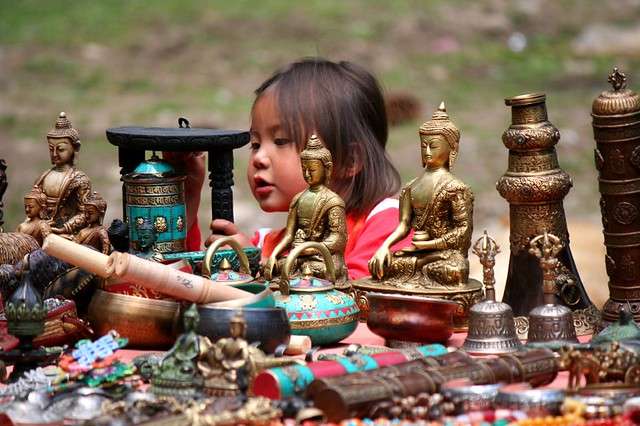
Balancing Tradition and Modernity
Bhutan has consistently sought to balance its traditional values with the demands of modern development. This delicate balancing act is evident in various policies and initiatives:
- Controlled tourism policy: Bhutan’s “High Value, Low Impact” tourism model aims to preserve the country’s culture and environment while benefiting from tourism revenues.
- Emphasis on renewable energy: The country has invested heavily in hydropower, not only meeting its own energy needs but also exporting clean energy to neighboring countries.
- Commitment to remaining carbon-neutral: Bhutan is one of the few carbon-negative countries in the world, absorbing more carbon than it emits thanks to its vast forests and low industrialization.
- Protection of biodiversity: The country has committed to maintaining at least 60% of its land under forest cover in perpetuity, enshrining this in its constitution.
- Preservation of traditional arts and crafts: Programs to support and promote traditional Bhutanese arts, crafts, and architecture ensure cultural continuity amid modernization.
Economic Development
While prioritizing happiness and well-being, Bhutan has not ignored economic progress. The country has pursued a measured approach to economic development, focusing on sustainable sectors and gradually opening up to the global economy:
- Hydropower development: Leveraging its abundant water resources to generate clean energy and export revenues.
- Promotion of high-value, low-impact tourism: Developing a niche in the global tourism market that aligns with the country’s values.
- Investment in education and healthcare: Focusing on human capital development to build a skilled and healthy workforce.
- Gradual opening to foreign investment: Carefully managed to ensure alignment with national priorities and values.
- Emphasis on organic agriculture: Positioning Bhutan as a producer of high-quality, organic agricultural products.
Transition from Monarchy to Democracy
A significant aspect of Bhutan’s development journey has been its peaceful transition from an absolute monarchy to a constitutional democracy. This process, initiated by the Fourth King and completed under the Fifth King, demonstrates the country’s commitment to good governance and the empowerment of its citizens.
Key milestones in this transition include:
- 2008: First democratic elections held, marking the shift to a constitutional monarchy
- 2011: Local Government Act passed, decentralizing power and promoting grassroots democracy
- Ongoing: Continuous efforts to strengthen democratic institutions and civic participation
This transition reflects Bhutan’s adaptive approach to governance, blending traditional respect for the monarchy with modern democratic principles.
Recent Developments and Future Vision
In recent years, Bhutan has set ambitious goals for its future development:
- 2023: Graduation from Least Developed Country (LDC) status, marking a significant milestone in the country’s development journey
- Vision 2034: Goal to become a high-income country by 2034, a decade earlier than initially planned
These goals represent Bhutan’s aspiration to accelerate its development while staying true to its core values and unique development philosophy.
The Gelephu Mindfulness City project emerges from this context – a bold initiative that seeks to embody Bhutan’s values and development approach in a 21st-century urban setting. It represents an evolution of the GNH concept, translating its principles into concrete urban planning and economic strategies.
As we venture deeper into the specifics of the Gelephu Mindfulness City project in the following sections, it’s essential to keep in mind this broader context of Bhutan’s development philosophy. The project is not just about building a new city; it’s about creating a living embodiment of Bhutan’s unique approach to progress – one that balances economic growth with environmental conservation, cultural preservation, and the well-being of all its inhabitants.
4. The Vision of Gelephu Mindfulness City
The Gelephu Mindfulness City project represents a bold reimagining of urban development, aligning with Bhutan’s values and addressing global challenges. It’s a vision that seeks to create not just a city, but a new paradigm for how we conceive of urban spaces in the 21st century.
Royal Vision and Leadership
The concept of Gelephu Mindfulness City was announced by His Majesty King Jigme Khesar Namgyel Wangchuck on December 17, 2023, during Bhutan’s National Day celebrations. This announcement marked what His Majesty described as an “inflection point” in Bhutanese history, challenging the current generation to take up the mantle of nation-building with fresh perspectives and progressive ideas.
Key aspects of the Royal vision include:
- Creating opportunities for Bhutan’s youth, addressing concerns of outmigration and brain drain
- Positioning Bhutan as a leader in sustainable and mindful urban development
- Leveraging Bhutan’s strategic location to enhance its role in regional and global trade
- Demonstrating how economic development can be pursued in harmony with nature and cultural values
His Majesty’s personal involvement in guiding the project speaks volumes about its national importance and ensures alignment with Bhutan’s broader development goals.
Scale and Scope
The Gelephu Mindfulness City is planned to span an impressive area of approximately 1,000 square kilometers (386 square miles), making it larger than Singapore. This scale allows for a extensive approach to urban planning that incorporates:
- Urban areas with mixed-use developments
- Extensive green spaces and wildlife corridors
- Agricultural zones integrated into the urban fabric
- Advanced transportation and communication infrastructure
The city is designed to eventually accommodate up to hundreds of thousands of residents, which would make it the largest urban center in Bhutan. This population reflects ambitious goals for economic growth and urbanization while maintaining a focus on quality of life and sustainability.
Core Principles
The vision for Gelephu Mindfulness City is guided by several core principles that reflect Bhutan’s values and address contemporary urban challenges:
- Mindfulness: Integrating spaces and practices that promote mental well-being and self-awareness, reflecting Bhutan’s Buddhist heritage and GNH philosophy.
- Sustainability: Prioritizing eco-friendly design, renewable energy use, and circular economy principles to create a carbon-positive urban environment.
- Innovation: Embracing cutting-edge technology to create a smart city that enhances efficiency and quality of life.
- Cultural preservation: Maintaining Bhutanese traditions and architectural styles while adapting them to modern urban needs.
- Economic growth: Attracting investments and fostering innovation while adhering to GNH principles.
- Human-nature harmony: Designing urban spaces that coexist with and enhance natural ecosystems.
- Global connectivity: Positioning the city as a hub for international trade and cultural exchange while maintaining Bhutanese identity.
Unique Features
Several unique features distinguish the Gelephu Mindfulness City vision:
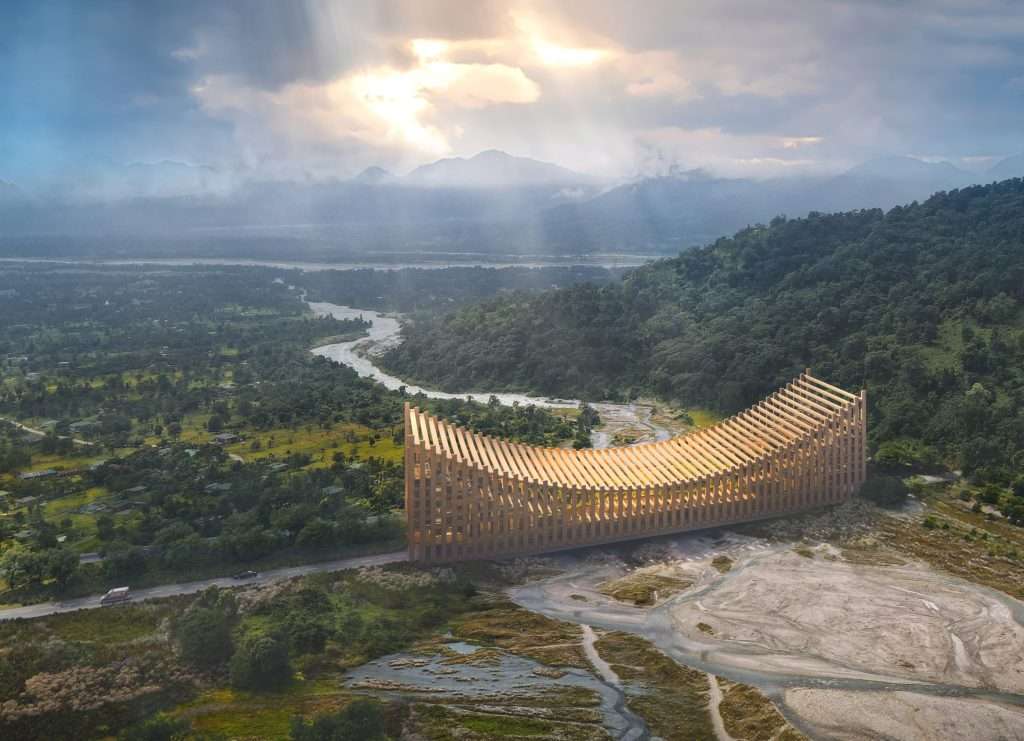
- Integration of spiritual practices: The city will include dedicated spaces for meditation and mindfulness practices, including a Vajrayana spiritual center.
- Wildlife corridors: Unlike most urban developments, the city plan includes corridors for wildlife movement, particularly for elephants that migrate between Bhutan and India.
- River-centric design: The city is planned around the 35 rivers that crisscross the area, respecting natural water flows and incorporating them into the urban landscape.
- Sustainable architecture: Buildings will be constructed using locally sourced, natural materials like stone, mass timber, and bamboo, with height restrictions to maintain harmony with the natural environment.
- Bridge-based urban hubs: A series of innovative bridges will serve as key urban centers, each reflecting one of the nine domains of Bhutan’s GNH index.
Economic Vision
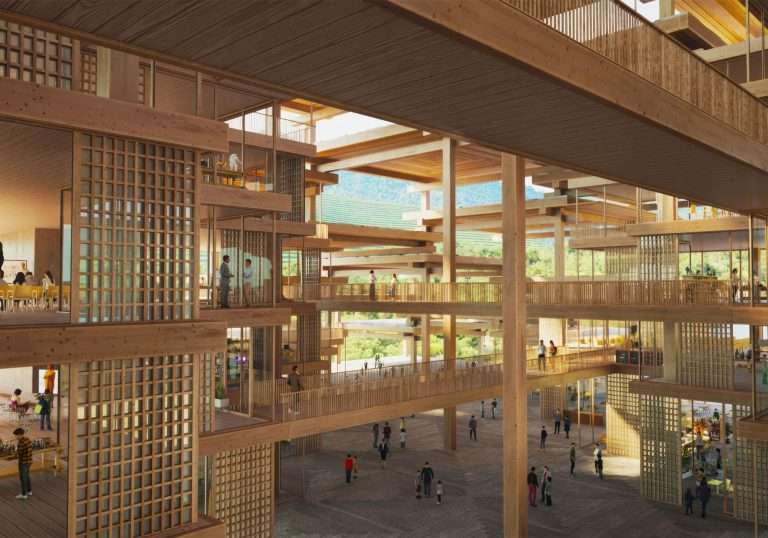
The economic vision for Gelephu Mindfulness City is multifaceted, aiming to create a diverse and resilient economy that can drive Bhutan’s growth while staying true to its values:
- Special Administrative Region: The city will have a unique legal and administrative framework to facilitate investment and innovation.
- Focus sectors: Seven core economic clusters have been identified, including spirituality, health and wellness, education, green technology, finance, agritech, and airport economy.
- Global business hub: The city aims to attract international businesses and professionals seeking to combine commercial success with sustainability and well-being.
- Regional connectivity: Leveraging Bhutan’s location to become a key node in trade between South Asia, Southeast Asia, and China.
Environmental and Cultural Integration
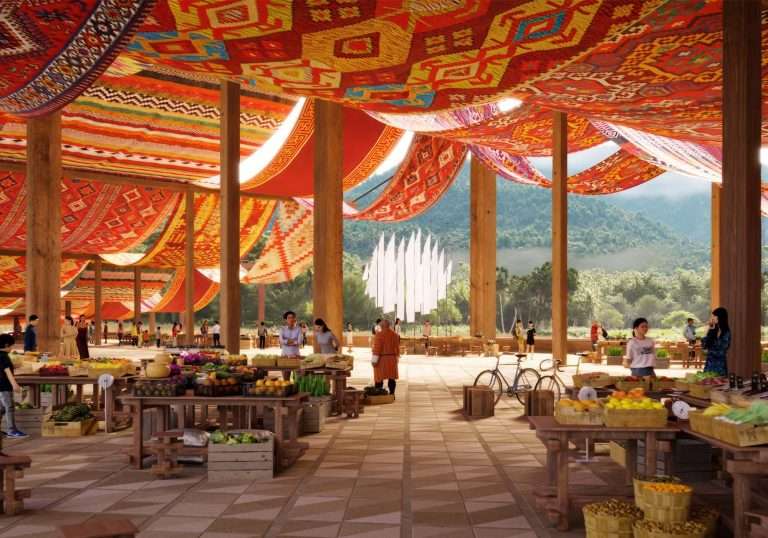
A key aspect of the vision is the seamless integration of the city with its natural and cultural environment:
- “Building with Nature” philosophy: Urban structures are designed to be integrated with their pristine surroundings, respecting the natural landscape.
- Cultural showcase: The city will serve as a living showcase of Bhutanese culture, from its architecture to its daily practices.
- Biodiversity preservation: Urban planning will prioritize the protection and enhancement of local ecosystems.
The vision for Gelephu Mindfulness City represents a holistic approach to urban development that seeks to address many of the challenges facing cities worldwide. It aims to demonstrate that economic growth, technological advancement, cultural preservation, and environmental sustainability can be pursued simultaneously and synergistically.
By reimagining what a city can be, Bhutan is not just planning for its own future, but potentially providing a model for sustainable urban development that could inspire cities around the world. The Gelephu Mindfulness City project embodies an ambitious vision of urban life that prioritizes human and environmental well-being alongside economic prosperity.
5. Urban Planning and Design
The urban planning and design of Gelephu Mindfulness City represent a radical departure from conventional urban development practices. Led by the renowned architectural firm Bjarke Ingels Group (BIG) in collaboration with Arup and Cistri, the design approach prioritizes harmony with nature, cultural integration, and human well-being.
Landscape-First Approach
One of the most innovative aspects of the Gelephu Mindfulness City plan is its “landscape-first” approach. As Giulia Frittoli, partner and head of landscape at BIG, explained, “We started with a landscape point of view before an urban point of view. We started from the environment.”
Key features of this approach include:
- River Integration: The city is designed around the 35 rivers that crisscross the area. The plan accommodates the natural expansion and contraction of these rivers, creating a dynamic urban landscape that respects natural water flows.
- Wildlife Corridors: Natural corridors up to half a mile wide are incorporated into the city plan, allowing for the movement of wildlife, including elephants, between the highlands and lowlands. This ensures that the urban development does not disrupt critical ecological processes.
- Urban Forests: Over 30% of the city area is dedicated to green spaces, including extensive urban forests. These areas serve multiple functions, including biodiversity conservation, air quality improvement, and providing recreational spaces for residents.
- Bioswales and Stormwater Management: A network of bioswales is integrated throughout the city to manage stormwater naturally, reducing flood risks and supporting the urban ecosystem.
Innovative Urban Structure
The city’s structure is designed to create a harmonious blend of urban and natural environments:
- Density Distribution: The upper part of the city will primarily consist of rice paddies and agricultural fields, while the southern portion, closer to India, will house most of the urban density.
- Bridge-Based Urban Centers: A series of nine types of bridges spanning the rivers will serve as major hubs and east-west connectors. Each bridge type reflects one of the nine domains of Bhutan’s Gross National Happiness index and will house key facilities such as healthcare centers, educational institutions, cultural spaces, and markets.
- Vertical Limit: Buildings will be restricted to approximately six stories high, ensuring that the urban skyline does not dominate the natural landscape.
- Integrated Agriculture: Urban farming, including rice paddies, is incorporated into the city plan, promoting food security and maintaining the area’s agricultural heritage.
Sustainable Architecture and Materials
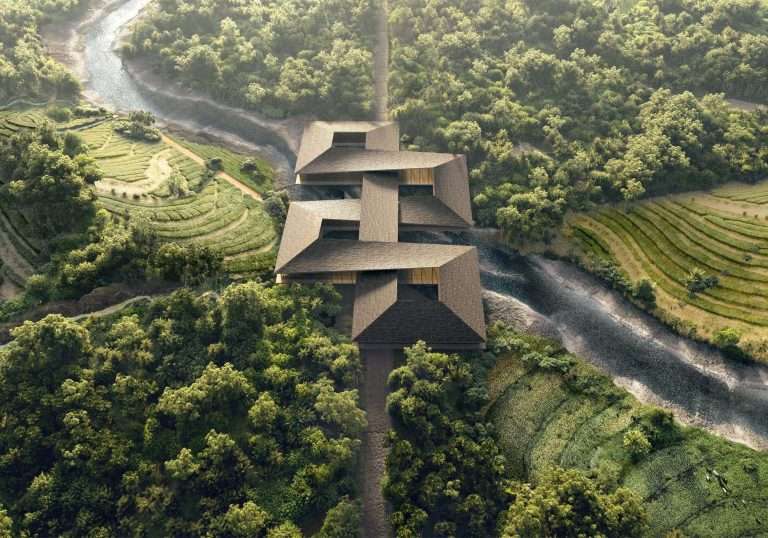
The architectural design of Gelephu Mindfulness City emphasizes sustainability and local context:
- Natural Materials: Buildings will primarily use locally sourced materials such as stone, mass timber, and bamboo, reducing the carbon footprint of construction and reflecting traditional Bhutanese building techniques.
- Climate-Responsive Design: Architectural elements will be adapted to the local climate, maximizing natural ventilation and daylight while providing protection from monsoon rains.
- Cultural Integration: The design incorporates elements of traditional Bhutanese architecture, reinterpreted for modern urban living.
Smart City Infrastructure
While respecting traditional values and natural systems, Gelephu Mindfulness City will also embrace cutting-edge technology:
- IoT-Enabled Services: The city will implement Internet of Things (IoT) technology for efficient management of utilities and public services.
- Data Analytics Center: A central facility will use big data and AI to optimize city operations and inform policy decisions.
- Digital Citizen Services: Residents will have easy access to government services through digital platforms.
- Smart Grids: Advanced energy management systems will ensure efficient distribution of renewable energy throughout the city.
Transportation Network
The transportation plan for Gelephu Mindfulness City prioritizes sustainability and efficiency:
- Walkability: The city is designed to be pedestrian-friendly, with wide sidewalks and car-free zones.
- Cycling Infrastructure: Over 200 km of dedicated cycling paths are planned throughout the city.
- Electric Public Transport: A fleet of electric buses and potentially a light rail system will provide clean public transportation options.
- International Connectivity: The new Gelephu International Airport and planned railway connections will enhance the city’s global and regional accessibility.
Phased Development
The urban plan acknowledges that building a city of this scale and complexity is a long-term process. The development is structured in phases:
- Initial Phase: Focus on core infrastructure, including the airport, key bridges, and essential urban services.
- Growth Phase: Gradual expansion of residential areas, commercial centers, and public facilities.
- Maturation Phase: Refinement of city systems, expansion of advanced facilities, and full integration of smart city technologies.
This phased approach allows for flexibility and adaptation as the city grows and evolves.
The urban planning and design of Gelephu Mindfulness City represent a bold experiment in creating a truly sustainable and mindful urban environment. By prioritizing the landscape, integrating natural systems, and blending traditional wisdom with modern technology, the plan seeks to create a city that nurtures both its residents and the surrounding ecosystem.
6. Economic Strategy and Potential
The economic strategy for Gelephu Mindfulness City is as innovative as its urban design, aiming to create a diverse, resilient, and sustainable economy that can drive Bhutan’s growth while staying true to its values.
Special Administrative Region Status
A cornerstone of the economic strategy is the establishment of Gelephu Mindfulness City as a Special Administrative Region (SAR) with executive autonomy and legal independence. This status will allow for:
- Implementation of investor-friendly laws and regulations
- Streamlined administrative processes
- Flexibility in economic policies to attract both domestic and foreign investment
The SAR status is designed to create an environment that is conducive to business and innovation while still adhering to Bhutan’s core principles and values.
Core Economic Clusters
The city’s economic development will focus on seven core clusters, each chosen for its potential to leverage Bhutan’s unique strengths and position the city as a leader in sustainable and mindful economic development:
- Spirituality: Leveraging Bhutan’s rich spiritual traditions to become a prominent center for Vajrayana Buddhism and spiritual tourism.
- Health and Wellness: Utilizing the pristine environment and focus on mindfulness to create world-class health and wellness centers, positioning the city as a leader in medical tourism and integrative medicine.
- Education and Knowledge: Developing higher education and technical learning institutions to foster a robust ecosystem of talent development and innovation.
- Green Energy and Tech Industries: Capitalizing on Bhutan’s renewable energy resources to support the development of green technology sectors, including green IT and potentially areas like sustainable cryptomining.
- Finance: Positioning the city as a gateway for investment opportunities in the region, especially for high-net-worth individuals and family offices.
- Agritech and Forestry: Expanding Bhutan’s export-oriented agri-food sector and capitalizing on sustainable forestry products like laminated timber.
- Airport Economy: Developing an aviation and logistics hub to cater to the growing travel demand in South Asia.
Investment Attraction Strategy
To attract both domestic and foreign investment, Gelephu Mindfulness City will offer a range of incentives and support mechanisms:
- Tax Incentives: Favorable tax rates and potential tax holidays for qualifying investments.
- Streamlined Regulations: Simplified processes for business registration, licensing, and operations.
- Infrastructure Support: State-of-the-art facilities and connectivity to support business operations.
- Talent Support: Programs to attract and retain both local and global talent.
- Funding Ecosystem: Development of a robust financial ecosystem, including venture capital and private equity networks.
Regional and Global Connectivity
The economic strategy leverages Gelephu’s strategic location to enhance Bhutan’s engagement in international markets:
- South Asian Hub: Positioning the city as a key node for trade between South Asia, Southeast Asia, and China.
- International Airport: The new Gelephu International Airport will enhance global connectivity for both passenger and cargo traffic.
- Railway Connections: Planned rail links will improve regional connectivity, particularly with India and potentially extending to other neighboring countries.
Sustainable and Mindful Business Practices
A unique aspect of the economic strategy is its emphasis on attracting businesses that align with the principles of Gross National Happiness and mindful development:
- Sustainability Criteria: Businesses operating in the city will be encouraged or required to meet specific sustainability standards.
- Corporate Mindfulness Programs: Promotion of workplace mindfulness and well-being programs.
- Circular Economy Initiatives: Encouragement of business models that minimize waste and maximize resource efficiency.
Skills Development and Employment
A key goal of the economic strategy is to create diverse employment opportunities for Bhutanese citizens, particularly the youth:
- Education-Industry Linkages: Collaborations between educational institutions and businesses to ensure skill development aligns with industry needs.
- Entrepreneurship Support: Programs to foster local entrepreneurship and innovation.
- Global Talent Attraction: Initiatives to attract skilled professionals from around the world, facilitating knowledge transfer.
Projected Economic Impact
While specific projections are yet to be released, the Gelephu Mindfulness City project is expected to have a significant impact on Bhutan’s economy:
- GDP Growth: Substantial contribution to Bhutan’s GDP, potentially accelerating the country’s journey to high-income status.
- Employment Generation: Creation of thousands of jobs across various sectors and skill levels.
- Foreign Direct Investment: Significant increase in FDI inflows into Bhutan.
- Export Diversification: Expansion of Bhutan’s export base beyond traditional sectors like hydropower.
The economic strategy for Gelephu Mindfulness City represents a bold attempt to create a new model of economic development that balances growth with well-being, sustainability, and cultural values. By focusing on sectors that align with Bhutan’s strengths and values, and by creating a unique regulatory and business environment, the city aims to become a catalyst for Bhutan’s economic transformation while setting a new standard for mindful economic development globally.
7. Environmental Considerations
Environmental sustainability is a cornerstone of the Gelephu Mindfulness City project, reflecting Bhutan’s strong commitment to conservation and its status as one of the few carbon-negative countries in the world. The environmental strategy for the city is comprehensive, aiming to not only minimize negative impacts but to actively enhance the local and global environment.
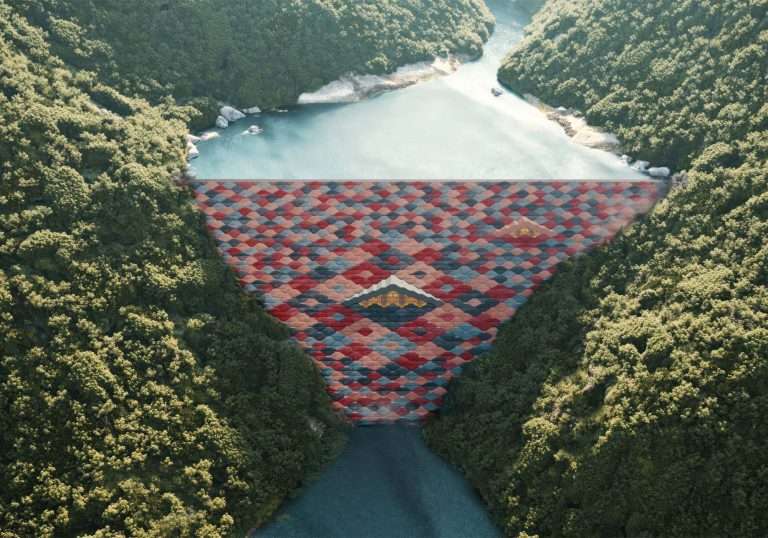
Renewable Energy
The city’s energy strategy is centered on 100% renewable energy use, primarily leveraging Bhutan’s abundant hydropower resources:
- Hydroelectric Dam: A new dam is planned as part of the project, which will not only power the city but also provide additional clean energy for export.
- Solar Integration: Building-integrated photovoltaics and solar farms will complement hydropower.
- Smart Grid Systems: Advanced energy management systems will optimize energy use and distribution.
- Energy Storage: Cutting-edge battery systems will be implemented to manage intermittent renewable sources effectively.
Biodiversity Conservation
Preserving and enhancing biodiversity is a key priority in the city’s design:
- Wildlife Corridors: Extensive natural corridors are integrated into the city plan to allow for the movement of wildlife, particularly elephants migrating between Bhutan and India.
- Native Species Planting: Landscaping throughout the city will prioritize native flora to support local ecosystems.
- Biodiversity Monitoring: Regular assessments will be conducted to track ecosystem health and the impact of urban development on local species.
- Education Centers: Facilities will be established to raise awareness about local biodiversity and conservation efforts.
Water Management
Given the city’s location in a river-rich area, water management is a critical aspect of its environmental strategy:
- River Preservation: The city’s design respects the natural flow of the 35 rivers in the area, allowing for their natural expansion and contraction.
- Stormwater Management: A network of bioswales and retention ponds will manage rainwater, reducing flood risks and replenishing groundwater.
- Water Recycling: Grey water systems and rainwater harvesting will be implemented throughout the city to reduce freshwater demand.
- Water Quality Monitoring: Advanced systems will continuously monitor water quality in rivers and urban water bodies.
Waste Management
The city aims to implement a circular economy approach to waste management:
- Zero Waste Goal: The city will strive for near-zero landfill waste through comprehensive recycling and upcycling programs.
- Organic Waste Processing: Composting and biogas production facilities will turn organic waste into resources.
- Advanced Recycling Facilities: State-of-the-art recycling plants will process a wide range of materials.
- Waste-to-Energy: Non-recyclable waste will be processed in environmentally friendly waste-to-energy plants.
Green Building Standards
The construction and operation of buildings in the city will adhere to strict environmental standards:
- Use of Sustainable Materials: Buildings will primarily use locally sourced, natural materials like stone, mass timber, and bamboo.
- Energy Efficiency: High standards for insulation, natural lighting, and energy-efficient systems will be mandated.
- Green Roofs and Walls: Integration of vegetation into building design to enhance biodiversity and reduce urban heat island effect.
- Water Efficiency: Buildings will be required to implement water-saving fixtures and rainwater harvesting systems.
Climate Resilience
Recognizing the challenges posed by climate change, the city’s design incorporates various resilience measures:
- Flood Management: Urban planning takes into account changing precipitation patterns and potential increases in river levels.
- Heat Island Mitigation: Extensive green spaces, reflective surfaces, and natural cooling systems will help manage urban temperatures.
- Drought Resistance: Landscaping will prioritize drought-tolerant species and efficient irrigation systems.
- Resilient Infrastructure: All infrastructure will be designed to withstand extreme weather events.
Environmental Education and Research
The city will serve as a living laboratory for environmental sustainability:
- Research Facilities: Dedicated centers for studying urban ecology, renewable energy, and sustainable development.
- Public Education Programs: Interactive exhibits and programs to engage residents and visitors in environmental issues.
- School Curriculum: Environmental education will be integrated into the curriculum of all schools in the city.
Carbon Sequestration
Beyond being carbon-neutral, the city aims to be carbon-positive:
- Urban Forests: Extensive tree planting programs will enhance the city’s carbon sequestration capacity.
- Carbon Capture Technologies: Exploration and implementation of innovative carbon capture and storage solutions.
- Carbon Offsetting Programs: Initiatives to offset any residual carbon emissions through local and regional projects.
The environmental considerations in the Gelephu Mindfulness City project go beyond mere compliance with eco-friendly standards. They represent a holistic approach to creating an urban environment that actively contributes to ecological health and resilience. By integrating natural systems into the urban fabric and prioritizing sustainability in every aspect of city life, Gelephu Mindfulness City aims to set a new global standard for environmentally conscious urban development.
8. Social and Cultural Aspects
The Gelephu Mindfulness City project places great emphasis on fostering a strong sense of community and preserving Bhutanese cultural values while embracing the opportunities of the 21st century. This section explores how the project aims to create a socially cohesive and culturally rich urban environment.
Community Design
The city’s layout and infrastructure are designed to promote social interaction and community bonding:
- Neighborhood Units: Residential areas are planned around community centers, encouraging local engagement.
- Public Spaces: Numerous gathering spots, from parks to plazas, are incorporated to facilitate social interaction.
- Intergenerational Living: The design caters to a mix of age groups and family structures, promoting diverse and inclusive communities.
- Co-Living and Co-Working Spaces: Shared living and working environments are encouraged to foster community bonds and resource sharing.
Cultural Preservation and Promotion
Maintaining and celebrating Bhutanese culture is a core aspect of the city’s design:
- Architectural Guidelines: New buildings are required to incorporate elements of traditional Bhutanese design, creating a unique urban aesthetic that honors cultural heritage.
- Cultural Centers: Dedicated spaces for performances, exhibitions, and workshops on Bhutanese arts and crafts.
- Festivals and Rituals: The city calendar will incorporate important cultural and religious observances, with appropriate spaces for celebrations.
- Language Promotion: Programs to promote the use of Dzongkha and other local languages in public life and education.
Education
The educational system in Gelephu Mindfulness City is designed to be innovative and holistic:
- Mindfulness in Curriculum: Meditation and emotional intelligence are integrated into school curricula at all levels.
- Vocational Training: Specialized centers prepare the workforce for emerging sectors like green technology and wellness tourism.
- Lifelong Learning: Facilities and programs cater to continuous education for all age groups.
- International Partnerships: Collaborations with global institutions facilitate knowledge exchange and research opportunities.
Healthcare
The city’s approach to healthcare emphasizes prevention and holistic well-being:
- Preventive Care Focus: Programs and facilities that prioritize wellness and healthy lifestyles.
- Integrative Medicine: Healthcare centers that combine modern medical practices with traditional Bhutanese healing methods.
- Telemedicine: Advanced technology enables remote health consultations, improving access to specialized care.
- Mental Health Support: Comprehensive services for psychological well-being, aligned with the city’s mindfulness ethos.
Spiritual Well-being
Reflecting Bhutan’s Buddhist heritage and the city’s focus on mindfulness, spiritual well-being is given significant attention:
- Vajrayana Spiritual Center: A landmark facility showcasing Bhutanese Buddhist traditions and offering spaces for meditation and spiritual retreats.
- Meditation Spaces: Public areas throughout the city designed for quiet reflection and meditation.
- Interfaith Dialogue: While honoring Bhutan’s Buddhist heritage, the city will also promote understanding and respect for diverse spiritual practices.
- Mindfulness Programs: Regular city-wide events and programs to promote mindfulness practices in daily life.
Social Inclusion and Equity
The city aims to be a model of social inclusivity and equity:
- Affordable Housing: Policies to ensure a mix of housing options catering to different income levels.
- Universal Design: Public spaces and buildings designed to be accessible to people of all abilities.
- Gender Equality: Programs and policies to promote equal opportunities and representation across all sectors.
- Multicultural Integration: As the city attracts residents from diverse backgrounds, initiatives will foster cross-cultural understanding and integration.
Work-Life Balance
In line with Bhutan’s emphasis on Gross National Happiness, the city will promote healthy work-life balance:
- Flexible Work Arrangements: Encouragement of policies that allow for remote work and flexible hours.
- Green Spaces Proximity: Urban design ensuring easy access to nature for all residents.
- Community Time Banks: Systems to encourage community service and mutual aid among residents.
- Leisure and Recreation: Ample facilities for sports, arts, and cultural activities to promote well-rounded lifestyles.
Technology and Society
While embracing technological advancements, the city will strive to maintain human connections:
- Digital Literacy Programs: Initiatives to ensure all residents can benefit from technological advancements.
- Ethical AI and Data Use: Strict policies on the use of artificial intelligence and data to protect privacy and promote fairness.
- Tech-Free Zones: Designated areas in the city where digital devices are discouraged to promote face-to-face interactions.
- Innovation in Social Technology: Encouragement of tech solutions that enhance community bonds and social well-being.
Arts and Creativity
The city will be a hub for artistic expression and creativity:
- Public Art Programs: Integration of art into public spaces, reflecting both traditional and contemporary Bhutanese creativity.
- Artist Residencies: Programs to attract artists from Bhutan and around the world, fostering cultural exchange.
- Creative Industries Hub: Support for the development of industries like film, music, and digital arts.
- Community Art Initiatives: Programs encouraging residents to participate in artistic activities and cultural production.
Civic Engagement and Governance
The city will promote active citizenship and participatory governance:
- Citizen Councils: Neighborhood-level bodies that participate in local decision-making.
- Digital Democracy Tools: Platforms for residents to engage in city planning and policy discussions.
- Transparency Initiatives: Open data policies and regular town halls to ensure accountable governance.
- Youth Leadership Programs: Initiatives to involve young people in civic processes and cultivate future leaders.
The social and cultural aspects of Gelephu Mindfulness City reflect a holistic approach to urban living that goes beyond physical infrastructure. By prioritizing community bonds, cultural preservation, spiritual well-being, and social equity, the city aims to create an environment where residents can thrive in all aspects of life. This approach not only honors Bhutan’s unique cultural heritage but also sets a new standard for how cities can nurture the social and cultural fabric of their communities in the 21st century.
9. Challenges and Opportunities
While the Gelephu Mindfulness City project offers immense potential, it also faces several significant challenges. Addressing these challenges effectively will be crucial for the success and sustainability of the project. This section explores both the challenges and the opportunities they present.
Challenges
- Financial Sustainability:
- Securing long-term investment for such a large-scale project.
- Ensuring economic viability while maintaining commitment to sustainability and well-being principles.
- Balancing the need for foreign investment with retaining local control and benefits.
- Environmental Impact:
- Managing the ecological footprint of large-scale urban development in a biodiversity-rich area.
- Balancing urban growth with Bhutan’s commitment to maintaining forest cover and carbon-negative status.
- Mitigating potential conflicts between urban development and wildlife, especially regarding elephant corridors.
- Cultural Preservation:
- Maintaining Bhutanese values and traditions in the face of rapid modernization and international influence.
- Balancing the influx of foreign ideas and practices with the preservation of local culture.
- Ensuring that economic development does not lead to erosion of traditional ways of life.
- Infrastructure Development:
- Creating advanced systems in a relatively underdeveloped region with challenging terrain.
- Ensuring reliable energy, water, and waste management systems that can scale with the city’s growth.
- Developing transportation infrastructure that connects the city both internally and externally.
- Skill Gap:
- Developing a local workforce capable of meeting the demands of a high-tech, sustainable city.
- Attracting and retaining skilled professionals while ensuring opportunities for local Bhutanese.
- Balancing the need for international expertise with the goal of building local capacity.
- Regulatory and Governance Challenges:
- Creating a new administrative framework that aligns with Bhutan’s national policies while offering the flexibility needed for a special economic zone.
- Ensuring effective governance and preventing potential issues like corruption or mismanagement.
- Navigating the complexities of international business laws and regulations.
- Social Integration:
- Managing the potential social tensions that may arise from rapid urbanization and demographic changes.
- Ensuring equitable development that benefits all segments of society.
- Addressing potential issues of gentrification and displacement of local communities.
- Regional Geopolitics:
- Navigating the complex geopolitical landscape of South Asia, particularly relations with India and China.
- Ensuring that the project enhances rather than complicates Bhutan’s diplomatic and economic relationships.
Opportunities
- Economic Diversification:
- Potential to significantly diversify Bhutan’s economy beyond traditional sectors like hydropower and agriculture.
- Opportunity to create a hub for sustainable and mindful businesses, attracting global investment.
- Possibility of developing new industries that align with Bhutan’s values and strengths.
- Innovation in Sustainable Urban Development:
- Chance to create a global model for environmentally conscious urban planning.
- Opportunity to pioneer new technologies and practices in areas like renewable energy, waste management, and green building.
- Potential to become a living laboratory for sustainable urban solutions.
- Cultural Showcase:
- Opportunity to showcase Bhutanese culture and values on a global stage.
- Potential to develop cultural industries and tourism in ways that respect and preserve local traditions.
- Chance to demonstrate how traditional values can be integrated into modern urban living.
- Educational and Research Hub:
- Potential to develop world-class educational and research institutions focused on sustainability, mindfulness, and innovation.
- Opportunity to attract international students and researchers, fostering knowledge exchange.
- Chance to build capacity in cutting-edge fields, benefiting Bhutan’s overall development.
- Regional Connectivity:
- Opportunity to position Bhutan as a key player in regional trade and cooperation.
- Potential to develop as a logistics and transportation hub connecting South and Southeast Asia.
- Chance to enhance Bhutan’s diplomatic and economic relationships in the region.
- Social Innovation:
- Opportunity to experiment with new models of community organization and civic engagement.
- Potential to develop innovative approaches to social issues like healthcare, education, and work-life balance.
- Chance to create a model for inclusive and equitable urban development.
- Environmental Leadership:
- Opportunity to demonstrate large-scale sustainable living and carbon-positive urban development.
- Potential to develop new approaches to human-wildlife coexistence in urban settings.
- Chance to become a global leader in urban biodiversity conservation.
- Technological Advancement:
- Opportunity to leapfrog older technologies and implement cutting-edge solutions across various sectors.
- Potential to become a testbed for emerging technologies in areas like smart city management, renewable energy, and digital governance.
The challenges facing the Gelephu Mindfulness City project are significant, but they also present unique opportunities for innovation and leadership. By addressing these challenges creatively and staying true to its founding principles, the project has the potential to not only transform Bhutan but also to provide valuable lessons and inspiration for sustainable urban development worldwide.
10. Implementation and Timeline
The development of Gelephu Mindfulness City is envisioned as a long-term project that will unfold over several decades. The implementation strategy is designed to be flexible and adaptive, allowing for adjustments based on lessons learned and changing circumstances. Here’s an overview of the planned implementation process and timeline:
Phase 1: Foundation and Initial Development (2024-2029)
Key Focus Areas:
- Detailed Planning and Design
- Land Acquisition and Preparation
- Core Infrastructure Development
- Pilot Projects and Proof of Concepts
Specific Activities:
- Finalize master plans and secure necessary approvals
- Begin land acquisition and resettlement processes where necessary
- Develop core utilities: water supply, sewage systems, electricity grid
- Start construction of the international airport
- Initiate development of key transportation links, including roads and initial railway connections
- Launch pilot projects for sustainable housing and commercial spaces
- Begin development of the first urban centers, including one or two of the signature bridges
- Establish initial governance structures for the Special Administrative Region
- Implement community engagement programs to involve local residents in the planning process
- Start promotional activities to attract initial investors and businesses
Phase 2: Growth and Expansion (2029-2034)
Key Focus Areas:
- Major Construction
- Economic Zone Development
- Population Growth
- Technology Implementation
Specific Activities:
- Accelerate construction of residential areas, commercial centers, and public facilities
- Complete and operationalize the international airport
- Develop green infrastructure including parks, urban forests, and biodiversity corridors
- Implement smart city systems and renewable energy infrastructure
- Establish key educational institutions, including the university and vocational training centers
- Develop healthcare facilities, including the central hospital and community clinics
- Launch major economic zones and attract anchor businesses in key sectors
- Expand transportation networks, including internal public transit systems
- Implement waste management and recycling systems
- Begin cultural and spiritual center construction, including the Vajrayana spiritual center
Phase 3: Maturation and Refinement (2034-2039)
Key Focus Areas:
- Population Increase
- Economic Diversification
- Cultural Integration
- Global Outreach
Specific Activities:
- Continue expansion of residential and commercial areas based on population growth
- Refine and optimize city systems based on data and resident feedback
- Further develop specialized economic clusters (e.g., wellness tourism, green technology hubs)
- Enhance cultural facilities and programs to solidify the city’s unique identity
- Expand international connections, including completion of all planned transportation links
- Implement advanced sustainability initiatives (e.g., circular economy systems, advanced renewable energy projects)
- Develop research and innovation centers in key fields
- Launch global knowledge-sharing initiatives, hosting conferences and welcoming researchers
- Refine governance structures and policies based on learnings from earlier phases
- Initiate long-term environmental impact studies and adaptation strategies
Phase 4: Full Realization and Future Planning (2039 onwards)
Key Focus Areas:
- Achieving Full Functionality
- Global Leadership in Sustainable Urban Development
- Long-term Sustainability and Adaptation
Specific Activities:
- Reach target population and full economic functioning
- Conduct comprehensive evaluation of the project’s impact on Bhutan’s development goals
- Refine and export models of sustainable urban living developed in the city
- Implement next-generation technologies and systems
- Develop strategies for long-term adaptation to climate change and other global challenges
- Establish Gelephu Mindfulness City as a global center for learning and innovation in sustainable urban development
Continuous Processes Throughout All Phases
- Regular Assessments: Conducting ongoing studies on the city’s impact on well-being, sustainability, and economic development
- Flexibility and Adaptation: Remaining open to changes in technology, global best practices, and local needs
- Community Feedback: Maintaining strong channels for resident input and participation
- Global Knowledge Sharing: Engaging with international partners, researchers, and other cities to share learnings and best practices
- Environmental Monitoring: Continuous tracking of the project’s environmental impact and biodiversity conservation efforts
- Cultural Preservation Initiatives: Ongoing programs to maintain and promote Bhutanese culture and values
This implementation timeline is designed to allow for organic growth and adaptation. It recognizes that building a city of this scale and complexity is a generational project that will evolve over time. The phased approach allows for learning and refinement at each stage, ensuring that the final result aligns with the vision of a truly mindful and sustainable urban environment.
11. Global Significance and Potential Impact
The Gelephu Mindfulness City project has the potential to influence urban development worldwide, offering innovative solutions to some of the most pressing challenges facing cities in the 21st century. This section explores the global significance of the project and its potential impact across various domains.
Redefining Urban Success
Gelephu Mindfulness City challenges conventional metrics of urban success:
- Beyond GDP: The project demonstrates how cities can prioritize well-being alongside economic growth, offering a real-world example of how Gross National Happiness principles can be applied in urban development.
- New Success Metrics: By developing and implementing measures of success based on holistic well-being, the city could inspire a global rethinking of how urban prosperity is defined and measured.
- Quality of Life Focus: The emphasis on work-life balance, community engagement, and spiritual well-being could influence global conversations on the purpose and design of cities.
Environmental Model
The project’s ambitious environmental goals could have far-reaching impacts:
- Carbon-Positive Urbanism: By aiming to be carbon-positive, the city could provide a blueprint for how large urban areas can operate without net carbon emissions and even contribute positively to climate mitigation.
- Biodiversity in Urban Settings: The integration of wildlife corridors and extensive green spaces into urban planning could revolutionize approaches to urban biodiversity conservation.
- Circular Economy Implementation: The city’s waste management and resource efficiency strategies could offer scalable models for circular economy principles in urban contexts.
Social Innovation
Gelephu Mindfulness City’s approach to social design and community building could influence urban social policies globally:
- Community-Centric Design: The city’s emphasis on fostering strong social bonds through urban design could provide valuable insights for addressing issues of social isolation in modern cities.
- Mindfulness at Scale: The integration of mindfulness practices into urban life could offer new approaches to addressing mental health and well-being in urban populations.
- Intergenerational Living: Strategies for promoting interaction and support across different age groups could inform global efforts to address demographic challenges like aging populations.
Technological Advancement
The city’s approach to technology integration could set new standards for smart city development:
- Ethical AI and Data Use: By prioritizing privacy and ethical considerations in its smart city implementations, Gelephu could provide a model for responsible technology use in urban environments.
- Human-Centered Tech: The balance of technological advancement with human needs and natural systems could offer lessons in creating tech-enabled cities that enhance rather than detract from quality of life.
- Innovation Ecosystems: The city’s plans for fostering innovation in sustainability and well-being technologies could create new paradigms for urban innovation hubs.
Cultural Preservation in Modernization
The project’s approach to balancing cultural preservation with modern development could have global relevance:
- Living Heritage: Demonstrating how traditional cultural practices and values can shape and enrich modern urban environments.
- Sustainable Tourism: The city’s approach to cultural tourism that respects local traditions and environments could influence global tourism practices.
- Architectural Fusion: The integration of traditional Bhutanese architectural elements with modern sustainable building practices could inspire new approaches to culturally resonant urban design worldwide.
Economic Model
Gelephu’s economic strategy could influence thinking on sustainable economic development:
Regional Economic Integration: The city’s role as a connector between South and Southeast Asia could offer lessons in how urban centers can facilitate regional economic cooperation.
Mindful Business Practices: The emphasis on businesses that align with well-being and sustainability goals could inspire new models of corporate social responsibility and purpose-driven enterprises.
Niche Sector Development: The focus on sectors like wellness tourism and sustainable technology could provide a model for other regions looking to develop unique economic niches.
Governance and Civic Engagement
The governance model of Gelephu Mindfulness City could inform new approaches to urban administration:
Participatory Urban Planning: The emphasis on community involvement in city development could provide models for more democratic urban planning processes.
- Transparent Governance: The city’s commitment to open data and transparent decision-making could set new standards for urban governance worldwide.
- Balancing Autonomy and Integration: The Special Administrative Region status of Gelephu could provide insights into how cities can balance local autonomy with national integration, a relevant model for many rapidly urbanizing regions.
Education and Human Development
The city’s approach to education and lifelong learning could have far-reaching impacts:
- Holistic Education Model: By integrating mindfulness and emotional intelligence into curricula, Gelephu could influence global trends in education.
- Lifelong Learning Infrastructure: The city’s emphasis on continuous learning opportunities for all ages could provide a model for adapting to rapidly changing job markets and technologies.
- Research and Innovation Focus: The planned research institutions focusing on sustainability and well-being could become global centers of excellence, attracting talent and generating innovative solutions.
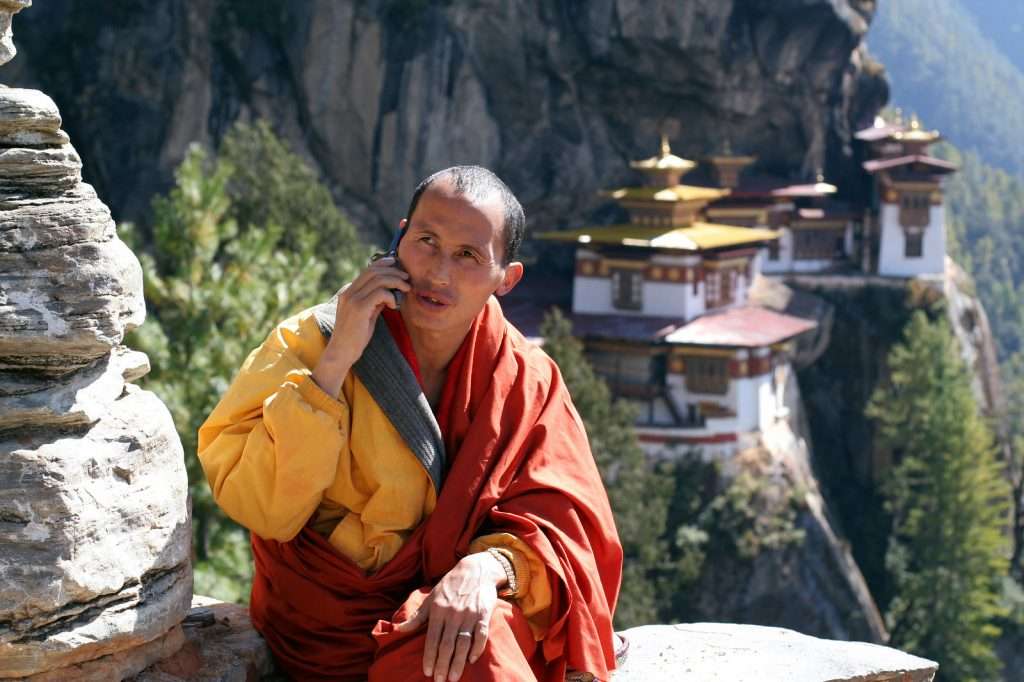
Health and Wellness Paradigm
Gelephu’s approach to health and wellness could influence global health policies:
- Preventive Health Focus: The emphasis on preventive care and healthy lifestyles could offer lessons for addressing the global rise in non-communicable diseases.
- Integrative Medicine Model: The combination of modern and traditional healing practices could provide insights for healthcare systems worldwide seeking to offer more holistic care.
- Urban Design for Health: The city’s layout and facilities designed to promote physical activity and mental well-being could inform urban health strategies globally.
Environmental Resilience and Climate Adaptation
As climate change poses increasing challenges to urban areas, Gelephu’s strategies could be particularly significant:
- Climate-Resilient Urban Planning: The city’s approach to flood management, heat island mitigation, and drought resistance could provide valuable lessons for cities worldwide.
- Ecosystem-Based Adaptation: The integration of natural systems into urban infrastructure could demonstrate effective strategies for enhancing urban resilience to climate impacts.
- Long-Term Environmental Monitoring: The city’s planned long-term studies on environmental impact could contribute valuable data to global understanding of sustainable urban development.
Inspiring Global Replication and Adaptation
While Gelephu Mindfulness City is uniquely tailored to Bhutan’s context, its principles and approaches could inspire adaptations worldwide:
- Scalable Solutions: Many of the city’s innovations could be scaled or adapted for use in existing cities, not just new developments.
- Policy Influence: The project could influence urban development policies in other countries, particularly in rapidly urbanizing regions of Asia and Africa.
- Global Partnerships: As a living laboratory of sustainable urban development, Gelephu could become a hub for international collaboration and knowledge exchange.
Challenges and Criticisms
It’s important to note that the global impact of Gelephu Mindfulness City will also depend on how it addresses potential challenges and criticisms:
- Economic Viability: The project will need to demonstrate that its holistic approach is economically sustainable in the long term.
- Scalability Concerns: Critics may question how applicable the model is to larger, more populous urban areas or to retrofitting existing cities.
- Cultural Specificity: The project will need to show how its principles, rooted in Bhutanese culture, can be adapted to diverse cultural contexts.
- Environmental Impact: Despite its sustainability goals, the project will face scrutiny over its overall environmental footprint, especially given Bhutan’s pristine natural environment.
12. Conclusion
The Gelephu Mindfulness City project represents a bold and visionary approach to urban development, one that seeks to harmonize economic growth with environmental sustainability, cultural preservation, and human well-being. As this ambitious project unfolds over the coming decades, it has the potential to serve as a global model for sustainable urban development, demonstrating how cities can be designed to nurture both people and the planet.
Key takeaways from this comprehensive overview include:
- Historical Context: Gelephu’s evolution from an ancient trading post to the site of a futuristic urban project reflects Bhutan’s broader journey of mindful development.
- Unique Vision: The project’s integration of Gross National Happiness principles with modern urban planning creates a distinctive approach to city-building.
- Innovative Design: From its landscape-first approach to its focus on biodiversity and cultural integration, Gelephu Mindfulness City pushes the boundaries of urban design.
- Economic Strategy: The focus on niche sectors like wellness, sustainable technology, and mindful business practices offers a new model for economic development.
- Environmental Commitment: The city’s ambitious environmental goals, including its aim to be carbon-positive, set a new standard for urban sustainability.
- Social and Cultural Emphasis: The project’s focus on community building, cultural preservation, and spiritual well-being offers a holistic approach to urban living.
- Technological Integration: The balanced approach to incorporating advanced technologies while maintaining human connections provides insights for future smart city developments.
- Challenges and Opportunities: While facing significant challenges, the project also presents unique opportunities for innovation and leadership in sustainable urban development.
- Global Significance: Gelephu Mindfulness City has the potential to influence urban development practices worldwide, offering new paradigms for measuring urban success, environmental stewardship, social cohesion, and governance.
As Gelephu Mindfulness City moves from concept to reality, it will undoubtedly face numerous challenges. The success of this ambitious project will depend on careful planning, adaptive management, and a continued commitment to its founding principles. If successful, however, Gelephu could offer invaluable lessons for addressing some of the most pressing urban challenges of the 21st century.
The world watches with keen interest as Bhutan embarks on this groundbreaking experiment in mindful urban living. As cities globally grapple with issues of sustainability, livability, and resilience, Gelephu Mindfulness City stands as a beacon of hope and innovation. It invites us to reimagine what our urban futures could look like if we place well-being, mindfulness, and sustainability at the heart of development.
In the words of His Majesty King Jigme Khesar Namgyel Wangchuck, this project represents an “inflection point” in Bhutanese history. It may well also represent an inflection point in global urban development, challenging us to think differently about the purpose and design of our cities. As the project unfolds, it will offer rich opportunities for learning, collaboration, and inspiration, potentially shaping the future of urban living worldwide.
The journey of Gelephu Mindfulness City is just beginning. Its ultimate impact will be determined not just by its physical development, but by how well it realizes its vision of a truly mindful, sustainable, and harmonious urban environment. As we look to the future, Gelephu Mindfulness City stands as a testament to the power of visionary thinking and the potential for cities to be catalysts for positive change in the world.



Given the low population of Bhutan, its commitment to carbon neutrality and its emphasis on cultural and environmental preservation, it is hard to understand the reasons for this project. Gelephu Mindfulness City will dramatically increase the population (presumably through immigration); erode the country’s enviable carbon neutral status (the new airport alone will probably make Bhutan a net carbon emitter); undermine the country’s unique cultural equilibrium and pose a de facto degradation of a currently nearly pristine environment (one that is home to hundreds of endangered Asian elephants.) Instead of embarking on this grandiose and environmentally destructive project why not simply further develop Bhutan’s nascent (though not insignificant) crypto-mining enterprise and use those revenues to upgrade the existing infrastructure; improve education and healthcare; and foster sustainable cultural-spiritual-technological innovations that can fuel a small-scale, high-powered entrepreneurial economy. One can look to Iceland as one fairly good example of well-managed growth, social well-being, and environmental conservation.